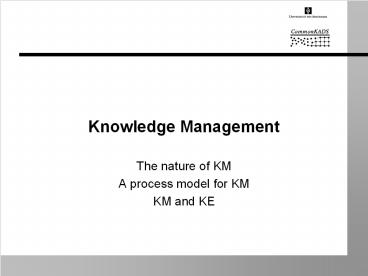Knowledge Management - PowerPoint PPT Presentation
Title:
Knowledge Management
Description:
Knowledge is seen as a resource. This means for knowledge management taking care that the resource is ... Due to specific properties of knowledge: intangible ... – PowerPoint PPT presentation
Number of Views:48
Avg rating:3.0/5.0
Title: Knowledge Management
1
Knowledge Management
- The nature of KM
- A process model for KM
- KM and KE
2
What is knowledge management?
- Knowledge is seen as a resource
- This means for knowledge management taking care
that the resource is - delivered at the right time
- available at the right place
- present in the right shape
- satisfying the quality requirements
- obtained at the lowest possible costs
- to be used in business processes
3
Why is knowledge management different?
- Due to specific properties of knowledge
- intangible and difficult to measure
- volatility
- embodied in agents with wills
- not consumed in a process, can increase through
use - wide ranging organizational impacts
- long lead times
- non-rival, can be used by different processes at
the same time
4
Continuous improvement of knowledge assets
Knowledge assets
Construct new knowledge
Apply your best knowledge
Value chain
5
Organization and improvement of care for knowledge
Create/change
Consolidate
Combine
Distribute
6
Modes of Knowledge Management
- Strategic
- What are the general changes to the knowledge
infrastructure? - Operational
- Organization the actual implementation and usage
of the knowledge infrastructure.
7
Levels in knowledge management
8
Knowledge management cycle
9
Knowledge object level
10
Four ambitions
11
Conceptualize the knowledge
- The Organizational Model is a good starting point
for creating a knowledge map. - The Task Model is a good starting point of
charting out where the knowledge is used. - The agent model is good for analyzing who owns
the knowledge and who uses it. - Knowledge items are central in KM.
12
Conceptualize main activities
- Inventarization of knowledge and organizational
context - Analysis of strong and weak points the value of
knowledge - Should deliver insights which can be used in the
next step for defining of and deciding between
improvements
13
Reflect bottleneck / opportunity analysis
- Can be done by using knowledge item descriptions,
generic bottleneck / opportunity types - time (only available during a limited period,
queuing, delay) - location (not available at the point where
needed, delay and communication, many windows) - form (difficult to understand, translation
processes, reformulation of knowledge) - nature (quality of knowledge, heuristic,
standardization) - stability (high rates of change, need to be up
dated) - current agents (vulnerability, carrier can/will
leave, few agents listed) - use in processes (limited re-use, reinventing the
wheel) - proficiency levels (current agents not well
skilled, opportunity to sell knowledge)
14
Act interventions
- Management, human resources and culture
- Education and training
- Reward system
- Recruitment and selection
- Management behavior
- Jobs organizational structure
- Staff department knowledge and strategy
- Department lessons learned
- Introduction of a 'buddy' system
- Teams with overlapping knowledge areas
- Out sourcing
- Acquiring and selling organizations
15
Act interventions (2)
- (Technological) tools
- Intranets internet for knowledge sharing
Lessons learned architectures - Groupware-based applications with knowledge
databases (best practices) - Decision Support Systems (expert systems, case
repositories, simulations) - 'who knows what' guide (knowledge map)
- Data mining
- Employee information system with knowledge
profiling - Document retrieval systems with advanced indexing
retrieval mechanisms
16
Knowledge management knowledge engineering
- Organization analysis feeds into knowledge
management (and vice versa) - Knowledge modeling provides techniques for
knowledge identification and development - Knowledge engineering focuses on common /
reusable elements in knowledge work































